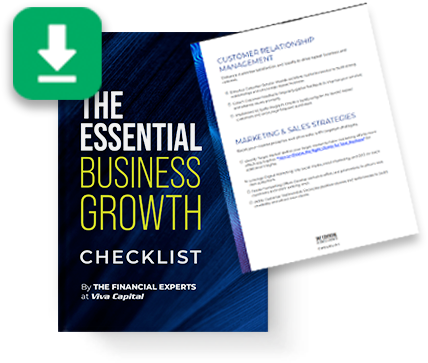
Business cash flow analysis and forecasting can make or break a small business, but it’s not always easy to know where to start if you don’t have a background in finance or accounting. On this page, we’ll provide a foundation of business finance concepts and cover:
- Why cash flow matters and how it can impact your business even if it’s profitable.
- What a cash flow analysis is, why it matters, and how to perform one.
- What cash flow forecasting is, why it matters, and how to make projections.
- What to do if your forecast predicts a cash flow shortfall.
Quick Definitions
Let’s start by defining some terms that will be used throughout this page. Use this section as a primer and refer to it as needed.
- Working Capital: The money your company has available to meet its financial obligations; usually represented as current assets minus current liabilities.
- Profit: The remaining balance when your business’s operating expenses are subtracted from revenue.
- Cash Flow: The net balance of cash moving into (cash inflows) and out of (cash outflows) your business at a specific point.
- Cash Flow Statement: A financial document that provides an analysis of what happened to a business’s cash during a specified period.
- Balance Sheet: A financial document that shows your business’s current assets and liabilities.
- Income Statement: Also referred to as a profit and loss (P&L) statement; a financial document that covers your business’s revenue, expenses, gains, and losses during a specified period.
- Cash Flow Analysis: Examining your business’s inflows and outflows during a specified period; usually uses your cash flow statement. This is a backward look at what has already happened.
- Cash Flow Forecasting: Also referred to as a cash flow projection, a prediction of how much cash your business will have during a specified period; often uses a balance sheet and income statement. This is a forward look at what is likely to happen.
How Does Cash Flow Affect a Business?
Many small business owners focus on profit – whether the business makes money over a set period of time. While profit is important, it’s actually poor cash flow management that’s behind eight in ten small business closures, per the National Federation of Independent Business (NFIB). This is because cash flow impacts:
- Payment of operating expenses
- Repayment of loans
- Qualification for loans
- Ability to purchase new equipment
- Ability to seize growth opportunities
Think of it this way: even if your business can turn a $1,000 investment into $10,000, your doors will close if you can’t get $1,000 to cover your business expenses.
Why is Cash Flow Analysis Important?
A cash flow analysis provides clues into a business’s overall financial health. Businesses and investors often analyze cash flow as the first step in cash flow planning and to identify:
- Whether the business had enough cash inflows to cover its outflows during a specified period.
- The business’s stage of growth.
- If there are mismatches between the business’s spending and income.
- If the business has cash left over to invest in itself.
Why is Cash Flow Forecasting Important?
Cash flow forecasting takes financial planning to the next level. Businesses often forecast or project cash flow to:
- Ensure enough cash is kept on hand so that the business can meet its day-to-day/ short-term financial obligations.
- Ensure enough cash is kept on hand to cover debts and interest or pay loans down quickly to minimize the overall cost to borrow.
- Identify how much cash will be on hand during key dates, such as the end of the month, quarter, or year.
- Identify potential cash flow shortfalls ahead of time, so the business has more time to prepare and develop a strategy to improve cash flow.
- Ensure the business has enough cash to fund growth-related initiatives.
What is a Cash Flow Statement?
A cash flow statement (CFS) summarizes a business’s cash inflows and outflows. A CFS can help a business understand how well it’s operating, where money is coming from, and how it’s being spent. Creditors will often request a copy of a business’s CFS before offering a loan because it offers insight into liquidity and how easy it will be for the business to make loan payments.
A CFS usually breaks business cash flows down into one of three groups:
- Cash flows from operating activities (CFO)
- Cash flows from investing (CFI)
- Cash flows from financing (CFF)
Cash Flows from Operating Activities
CFOs on a CFS reflect how much cash a business generates from its products and services. For example:
- Payments made to your business from customers
- Interest payments made from your business to creditors
- Payments made from your business to suppliers
- Salary and wage payments made from your business to employees
- Income tax payments
- Rent or mortgage payments
Cash Flows from Investing Activities
CFIs on a CFS relate to cash inflows and inflows from a business’s investments. For example:
- Purchase or sale of equipment and other assets
- Payments related to mergers and acquisitions (M&A)
- Purchase of marketable securities
Cash Flows from Financing Activities
CFFs on a CFS include things like cash from banks and investors as well as cash to shareholders. For example:
- Dividends
- Payment for stock repurchases
- Repayment of debt principal
How is Cash Flow Calculated?
There are two methods used to calculate cash flow: direct and indirect. The best or easiest way to calculate cash flow depends on whether the business uses the cash basis accounting method or the accrual basis accounting method.
- With cash basis accounting, the business doesn’t count revenue or expenses until money changes hands.
- With accrual basis accounting, the business counts revenue and expenses when an invoice is sent, or the business receives a bill. Most businesses use this method.
Direct Cash Flow Calculation Method
The direct cash flow method involves adding up all cash received (inflows) and all cash paid (outflows).
Indirect Cash Flow Calculation Method
With the indirect cash flow method, the business lists its net income first, then lists all its inflows and outflows, and the final net cash increase or decrease over the set period is calculated.
Direct vs. Indirect Cash Flow Calculation Methods
The direct cash flow method is the more accurate of the two because the figures represent the real cash the business has or does not have.
The cash basis accounting method becomes more complicated and time-consuming as the number of inflows and outflows grows. Because of this, most large businesses use the indirect cash flow calculation method instead.
Cash Flow Analysis: How is a Cash Flow Statement Interpreted?
Cash flow statements make it easier to gauge the financial health of a company and can often provide clues as to what stage of growth the business is in.
Positive Cash Flow
When a cash flow statement shows a positive cash flow, it is a strong indicator that more money is moving into the business than out over the specified period.
This is usually an ideal situation because it typically means the business can cover its expenses and invest in growth. However, positive cash flow is not the same thing as profit.
A business can have positive cash flow without turning a profit. For example, a cash injection into the business from a loan would create positive cash flow.
Negative Cash Flow
Negative cash flow means there is more money flowing out of the business than into the business during the specified period.
Again, this doesn’t relate to profit. For example, cash flow may be negative if the business saved for some time and then purchased new equipment during the specified period. Businesses that are rapidly growing or that invest in growth may also have negative cash flow.
Because of this, a single cash flow statement isn’t always helpful by itself. If you’re analyzing cash flow, it’s better to compare multiple periods and compare changes.
How is Cash Flow Forecasted?
Just as there are direct and indirect methods of calculating cash flow, there are direct and indirect methods for forecasting.
Direct Cash Flow Forecasting Method
The direct cash flow forecasting method requires that you have a complete list of all payables due during the period as well as all receivables expected during the period. Then, to complete the forecast, you simply add up each anticipated payable and receivable for the period.
Indirect Cash Flow Forecasting Method
The indirect cash flow forecasting method uses the income statement (P&L) and the balance sheet. Start with the net income, then add or subtract balance sheet items that either impact profit (but not cash flow) or cash flow (but not profit).
Direct vs. Indirect Cash Flow Forecasting Methods
The direct cash flow forecasting method works best for smaller businesses and is ideal for short-term forecasting. For an example, you might use the direct cash flow forecasting method to determine if you can afford to make payroll on a monthly basis or make an extra loan payment in order to cut back on interest payments A large business might leverage the direct method if accuracy during a small window is essential.
As the number of inflows and outflows increases, the direct method becomes more complicated. This is why 98 percent of businesses use the indirect method, according to the textbook “Financial Accounting for MBAs.” It’s more suitable for large businesses and long-term cash flow planning.
With that said, there isn’t a singular “best way to forecast cash flow.” Businesses often switch between the two depending on why they’re conducting a cash flow forecast and the length of the period involved.
Be Prepared with Viva
It’s normal for businesses to have limited cash flow or even negative cash flow when they’re growing. By analyzing cash flow, you can get a clearer picture of how your business is performing and how your cash is being managed.
However, it only tells you what’s already happened, which means you can only take a reactive approach. Forecasting helps you identify what’s likely to happen, so you can take a proactive approach and either cut back on outflows or increase your inflows when you predict a tight or negative period.
That’s where Viva comes in. We accelerate payment on your B2B invoices, so you get cash when you need it without taking on debt. To learn more or get started, request a complimentary quote.
- How Subcontractor Early Payment Programs Build Relationships - May 29, 2025
- Invoice Factoring Costs: Are They Worth It? - May 2, 2025
- 7 Proactive Tactics for Avoiding Invoice Disputes - March 3, 2025



